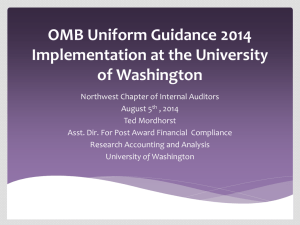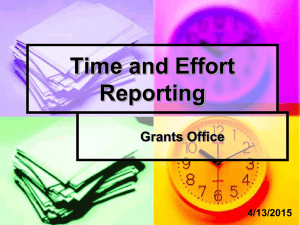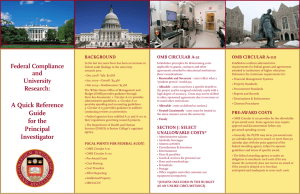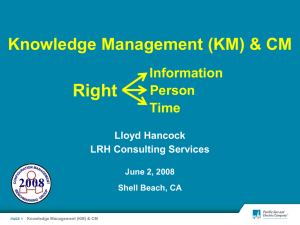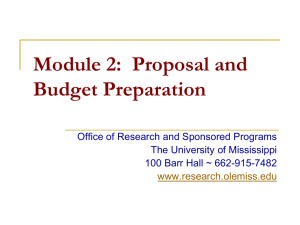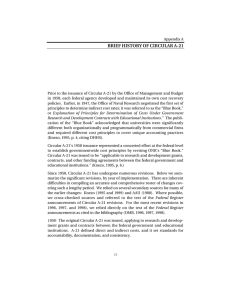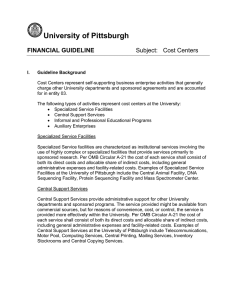Post COBRE and INBRE Funding: Best Practices to Sustain
advertisement
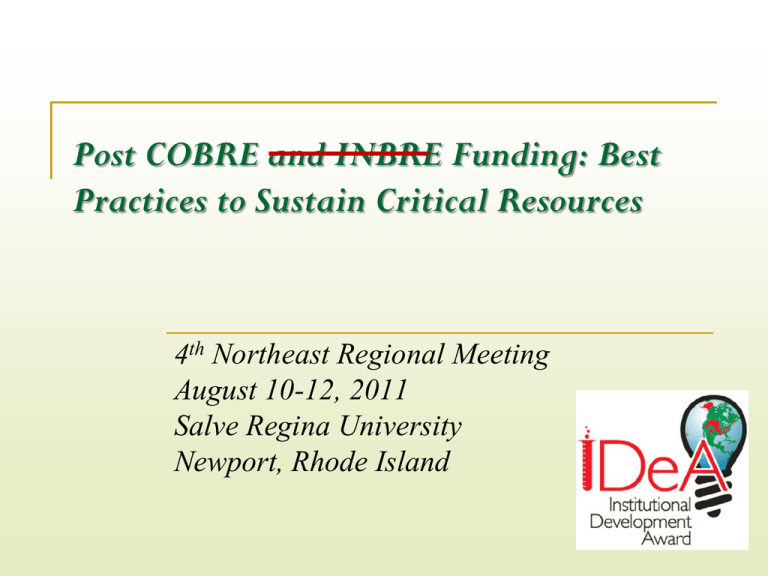
Post COBRE and INBRE Funding: Best Practices to Sustain Critical Resources 4th Northeast Regional Meeting August 10-12, 2011 Salve Regina University Newport, Rhode Island Tim Hunter University of Vermont Core Director VGN Microarray Facility Core Director, VCC DNA Analysis Facility Core Director, Advanced Genome Technologies Core (AGTC) Asst Director, Translational Technologies Unit, CCTS 2 What We Have Learned: Common Issues Some NCRR-funded cores are isolated: No easy access to medical schools (ID) Sometimes difficult to hire specialized staff Some cores want to do outreach but don’t know how Information does not get to them, need a central place Most were not aware of the opportunities for networking in the “Core Community” Very few attendees are aware of federal regulations regarding core fees structure – where is the information? Most had never developed chargebacks or a business plan to sustain critical core activities beyond NCRR funding. No formal standards on how core charge back should be implemented. Need for a workshop on core management (Best Practices)? Why Implement Best Practices Transparency Increase Visibility of Core Establish and maintain High Quality Services Promotes User confidence, Education, and Awareness Professional Development Benchmarking (www.abrf.org) Open Houses, Workshops, and Tutorials User Oversight Sustainability Sustaining technologies/services crucial to Research Institute Best Practices: Short List Developing a Business Plan Developing a full cost recovery Budget Evaluate Impact of Core Facility on Research Competiveness Marketing/Customer Relations (Steve, Jim, Jackie) Best Practices: Longer List 3-5 Year Business Plan Developing full cost recovery Budget , regardless of subsidies Make sure technologies/services are congruent with the organization’s mission and vision. Financial benchmarking: internal and external Access/ Utilization (user friendly) Technical benchmarking: internal and external Educational outreach: internal and external Impact and Outcomes (tracking) Local and Global Oversight: Communication and promotion Developing a Business Plan Clear Mission Organizational Structure Inventory of resources Maintenance plans Operational Plan Staffing, delivery of services (QC,QA, user relations), LIMS Marketing Plan Financial Planning Technology Assessment 3-5 Year outlook of future needs Technology Assessment, Financials Web Resources: Business Planning OMB Circular A-21 Basics: http://www.aucd.org/docs/urc/A21basics.pdf OMB Circular A-21 Cost Principles for Educational Institutions http://www.whitehouse.gov/sites/default/files/omb/circulars/a021/a21_2004.pdf Business Plan for a Startup Business: Including narratives and several financial worksheets( from SCORE): http://www.careerramblings.com/pdf/cr_business_plan.pdf (Request for comments on) FAQs to Explain Costing Issues for Core Facilities: http://cancer.osu.edu/research/cancerresearch/sharedresources/Documents/NIH%20%20Core%20Facilities%20FAQs.pdf SCORE: Free Small Business Advice, How-to-Resources, tools: http://www.score.org/ All Posted on NICL website Developing a full cost recovery Budget “The Crash Course” Developing a full cost recovery Budget Project Utilization Define service/billable units % Effort of each staff dedicated to delivery Determine true cost of service (Direct) Indirect Cost Service contract, consumables, reagents Administration, consulting, space costs, communications Instrument Depreciation Fully loaded chargeback Applying Dept, center, college subsidies Must be Circular A-21 Compliant Direct vs. Indirect (F + A) Direct Costs – can be identified specifically with delivery of a particular service/technology. i.e., labor, operating supplies and materials, service contracts, depreciation on non-federally purchased equipment. Indirect Costs – Costs that are incurred for common or joint objectives and cannot be readily identified to a specific service/technology. i.e., space, administration, travel, communications (phone, copier), deficit recovery Developing a full cost recovery Budget Service Utilization Annual Survey Email solicitation History i.e., Fragment Analysis Define Service Billable Unit: Injection Std and Titration provided Developing a full cost recovery Budget Determine % direct efforts for each staff Developing a full cost recovery Budget Service cost analysis (S) Direct (S+L) cost for delivery of defined service Developing a full cost recovery Budget Direct Core Operating Principles: Best Practices in determining chargebacks The costs of providing service are allowable, allocable, consistently applied and reasonable. The rates are established to recover these are documented and systematically evaluated against actual cost and revised on a regular basis to reflect actual costs (A-21 J.47) These rates are charged to all users on a consistent basis, regardless of funding source(s) and employing a principle of “one service, one rate”. Evaluating Impact of Core Facility on Research Competitiveness: Essential Metrics Kinds of services provided Staffing Grant proposals and (by PI, dates of submission or funding, title, and agency) Funded grants that used data from the facility. List of publications that used data from the facility. Numbers of completed projects for internal faculty and students sorted by college or school (the units of a project will vary by facility) Numbers of clients outside Institute, if any Essential Metrics Budget Information Financial benchmarking: internal and external Access/ Utilization Technical benchmarking: internal and external Educational outreach: internal and external Impact and Outcomes Local and Global Oversight: Communication and promotion Professional Development (Expertise) ?????? Lots of Lingering Questions ?????? Funding Landscape Post COBRE Movement of IDeA States Programs to NIGMS 19 NIH/NCRR Meetings on Efficient Core Management The Efficient Management and Utilization of Core Facilities July 14 – 15, 2009 managing core facilities issues of cost efficiency, management and access finding and accessing core facilities government policies governing managing and reporting training core directors quality improvement Moving Forward in the Efficient Management and Use of Core Facilities November 15 – 16, 2010 updates on maximizing the use and efficiency of existing NIH-funded research core facilities developing effective training programs for core facility directors exploring software options for enhancing administrative management of core facilities creating a national registry of core resources standardizing compliance with OMB Circular A21 NISBRE 2012: What workshops or presentations would be of greatest value to the NICL community?
